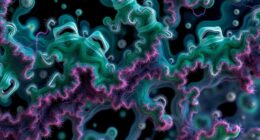Creating engaging art analysis activities can transform your classroom experience. Start by using slow looking techniques to encourage deep observation; spend at least 15 minutes focused on details. Incorporate collaborative puzzle activities, breaking artworks into segments for group discussions. Try the Think-Puzzle-Explore method to promote curiosity and critical thinking among students. Hands-on experiences, such as interactive projects, will boost engagement and enjoyment. By connecting art to historical context and personal experiences, you'll enrich students' understanding. As you explore these strategies, you'll discover even more ways to bring art analysis to life effectively.
Key Takeaways
- Implement slow looking techniques to encourage detailed observation and deeper engagement with artworks over an extended period.
- Use collaborative puzzle activities to break down artworks, fostering teamwork and open dialogue among participants.
- Apply the Think-Puzzle-Explore method to guide structured inquiry and promote critical thinking during art analysis.
- Incorporate hands-on experiences and interactive activities to enhance student engagement and enjoyment in analyzing art.
- Provide professional development opportunities for educators to refine their art analysis strategies and share best practices.
Importance of Art Analysis
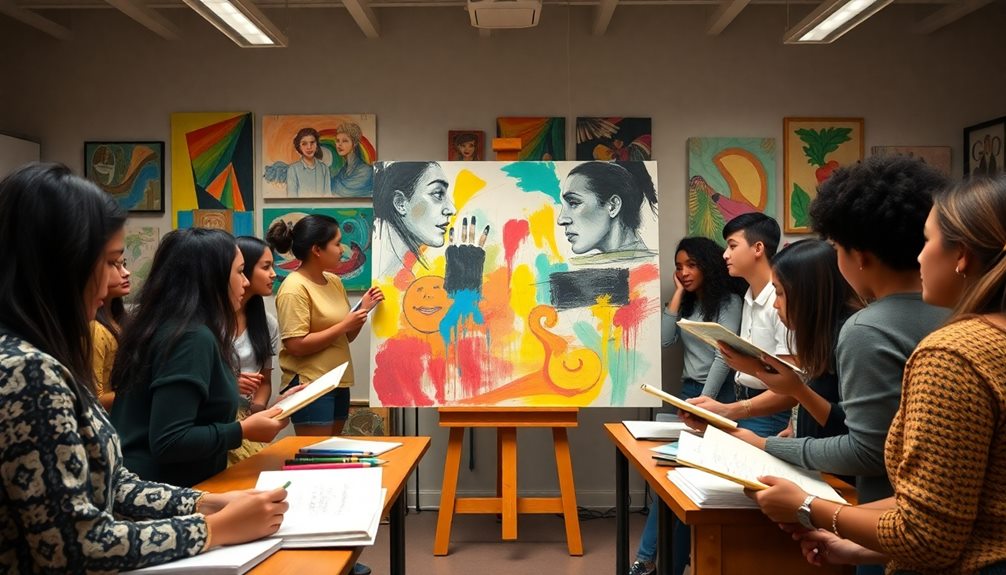
While you might appreciate art at first glance, exploring art analysis can greatly enhance your understanding and engagement with it. When you take a moment to observe a piece, even for just 30 seconds, you'll likely notice visual elements that you might've missed. This practice fosters critical thinking, prompting you to question why an artist chose specific colors or shapes.
Understanding the importance of art theory can provide foundational knowledge that further deepens this analytical process. By paying close attention to details, you develop a deeper understanding of the artwork's context and meaning.
Analyzing art encourages creativity and experimentation, allowing you to explore your interpretations and insights. This process transforms passive observation into an active dialogue between you and the artwork.
Moreover, engaging with art through analysis supports your growth as an artist, sharpening your analytical skills essential for thorough art education. As you explore deeper, you not only develop an appreciation for the work itself but also for the myriad of techniques and emotions that artists convey.
Ultimately, art analysis enriches your experience, helping you forge personal connections to artworks that can greatly enhance your overall learning experience and artistic expression.
Effective Teaching Strategies
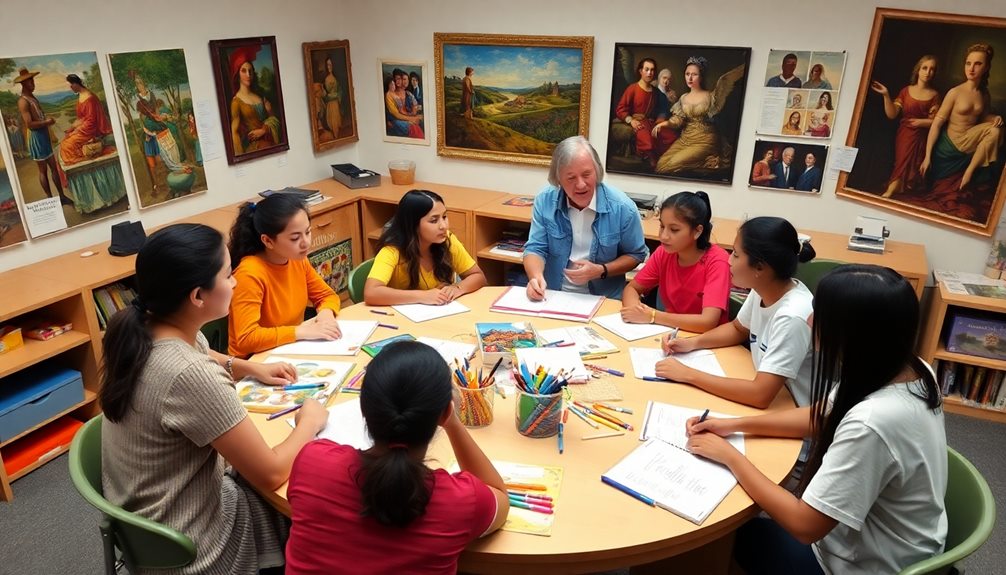
When you use Slow Looking techniques, your students sharpen their observational skills and engage more deeply with art.
Collaborative Puzzle Activities foster teamwork and allow students to share diverse perspectives, enhancing their understanding of visual elements.
Incorporating the Think-Puzzle-Explore Method sparks curiosity and encourages personal connections, leading to a richer exploration of artistic intent.
Slow Looking Techniques
Engaging in Slow Looking techniques transforms the way students interact with art, allowing them to immerse themselves in the details of each piece. By dedicating a minimum of 15 minutes per artwork, students learn to absorb visual information, focusing on specific elements without being influenced by the artist's name or the title. This approach turns them into art detectives, encouraging independent interpretation and deeper engagement.
As they observe, students develop their artistic skills, honing their ability to notice nuances in color, form, and texture. After the observation period, facilitating engaging discussions can reveal unexpected insights and enhance critical thinking. These conversations encourage students to articulate their observations and interpretations, leading to a richer understanding of the artwork.
Implementing Slow Looking techniques in your art curriculum not only fosters appreciation for art but also promotes thoughtful dialogue among students. By slowing down and examining art closely, they form meaningful connections with the pieces, ultimately transforming their approach to art appreciation.
In this way, Slow Looking techniques become a powerful tool for developing both observational skills and critical engagement in art education.
Collaborative Puzzle Activities
Collaborative Puzzle Activities break down artworks into manageable segments, inviting students to immerse themselves in specific details and share their findings. This strategy allows students to work together, analyzing different parts of an artwork before piecing it back together.
By engaging in small groups or pairs, students can present their insights, fostering open dialogue and critical thinking. As they discuss their assigned segments, students enhance their observational skills and learn to articulate their thoughts effectively, which deepens their overall art appreciation.
This method not only promotes teamwork but also encourages personal connections with the artwork, making the experience more meaningful. You can adapt Collaborative Puzzle Activities to various artworks, allowing for flexibility in themes and discussions.
Whether it's a classic painting or a contemporary piece, this approach helps students engage with the material in a dynamic way. The collaborative nature of these activities guarantees that every student has a voice, creating an inclusive environment where everyone can contribute.
Think-Puzzle-Explore Method
The Think-Puzzle-Explore Method ignites curiosity by guiding you through a structured process of inquiry. This engaging approach prompts you to investigate art analysis, allowing students to develop critical thinking skills while exploring the depths of various artworks.
As you progress through each phase—Think, Puzzle, Explore—you'll foster a collaborative learning environment where insights flourish.
- Think: Formulate questions about the artwork that pique your interest.
- Puzzle: Identify what you wonder about these questions and clarify your thoughts.
- Explore: Investigate your ideas through discussions and research, connecting observations to personal experiences.
- Engagement: Encourage students to articulate their findings and share perspectives.
- Connection: Relate artworks to real-life experiences, making art education relevant.
Professional Development Opportunities
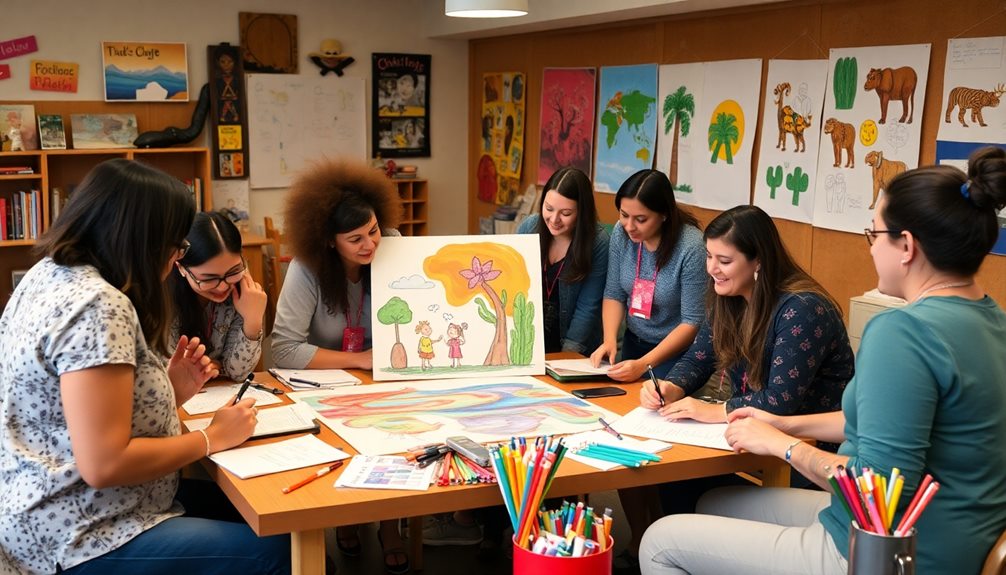
While many art educators seek to enhance their teaching skills, professional development opportunities play an essential role in achieving that goal. Participating in programs like the Summer Teacher Institutes at the National Portrait Gallery can notably improve your art techniques and teaching strategies.
These workshops focus on hands-on looking strategies, providing you with tools to help your students to use their problem-solving skills effectively while analyzing art. Engaging in such programs not only enriches your own understanding but also fosters a culturally intelligent approach to art education, as you learn to appreciate diverse artistic expressions and perspectives enhanced cross-cultural competence.
Accessing free resources, such as the downloadable Reading Portraiture Guide, gives you additional strategies to integrate into your curriculum. By exploring various artistic styles and in-depth art analysis, you create a more engaging learning environment.
Community engagement initiatives also foster collaboration among art teachers, allowing you to share best practices and innovative approaches that inspire creativity.
These professional development opportunities not only enhance your skills on a larger scale but also encourage you to implement fresh ideas in your classroom. By embracing these resources and experiences, you'll be better equipped to guide your students in understanding and appreciating art in a meaningful way.
Essential Resources for Educators
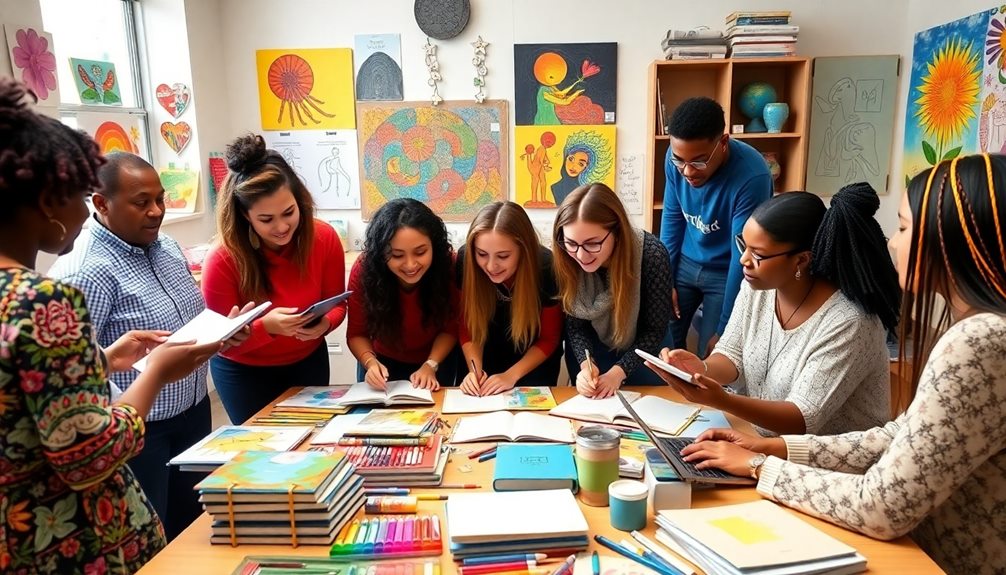
In your quest to enhance art education, accessing crucial resources can make a significant difference. By equipping yourself with these tools, you can encourage students to engage deeply with various works of art, including engravings, and explore different techniques in art analysis.
Here are some crucial resources to reflect upon:
- Reading Portraiture Guide: A free download that provides looking strategies tailored to enhance analytical skills.
- National Portrait Gallery Programs: Offers various educational initiatives for both students and educators, focusing on effective art engagement.
- Education Page of the National Portrait Gallery: A treasure trove of essential information about available programs to boost art analysis skills in the classroom.
- Summer Teacher Institutes: Hands-on experiences to support your professional development and innovative looking strategies.
- Community Engagement Opportunities: Collaborate with fellow educators to share practices and access free resources that enhance your teaching methods.
Engaging Analysis Techniques
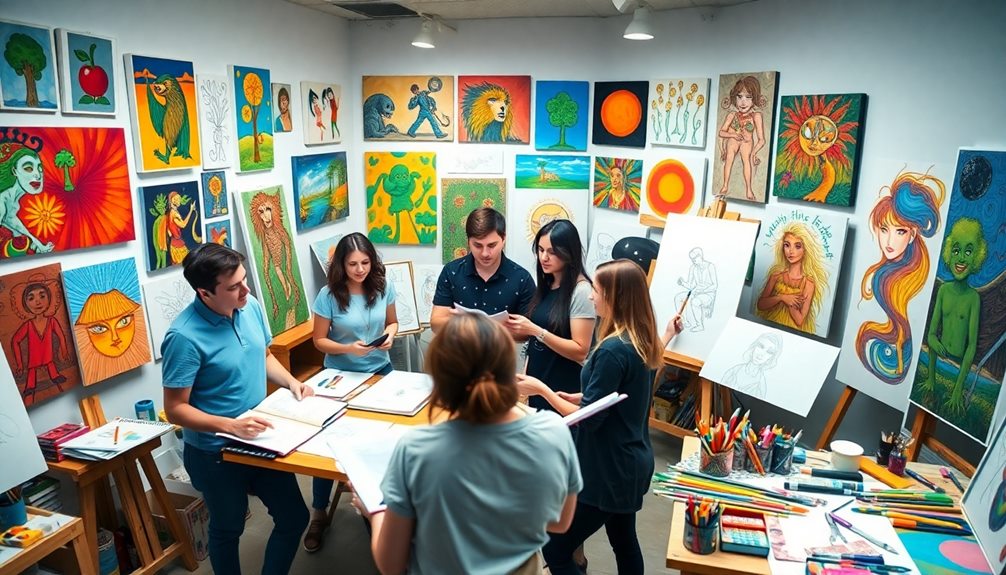
Engaging in art analysis can transform students' understanding and appreciation of visual art. Using engaging analysis techniques allows you to deepen their observational skills and critical thinking.
One effective method is Slow Looking, where students spend at least 15 minutes examining a single artwork. This practice promotes a deeper engagement with the piece and enhances their ability to notice details.
Another strategy, the 30 Second Look, encourages quick observation followed by discussion of recalled details, fostering immediate recall and critical thinking.
The Puzzle Activity invites students to collaboratively analyze segments of an artwork, fostering teamwork and promoting shared insights.
You can also utilize the Think, Puzzle, Explore Method to inspire curiosity. This technique guides students to ask questions, explore personal connections, and engage in deeper conversations about the artwork.
By incorporating hands-on experiences through art activities and looking techniques, you actively involve students in art analysis. These engaging techniques help students develop a richer learning experience and a profound appreciation for visual art.
Each activity not only enhances their skills but also makes the analysis process enjoyable and thought-provoking.
Contextual Understanding of Art
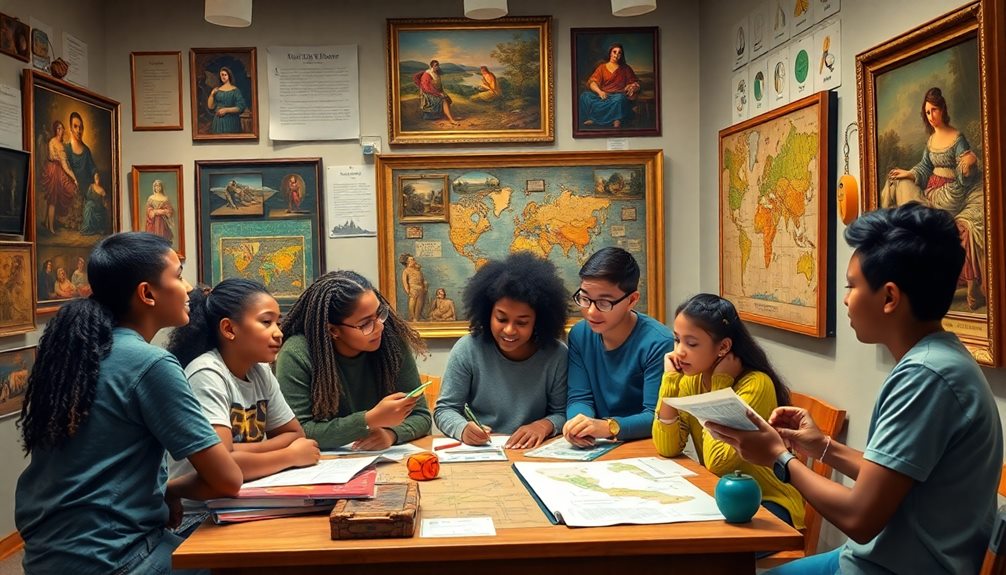
Understanding the context in which art is created enriches your appreciation and interpretation of the piece. By looking into the historical and cultural backgrounds, you can lend greater meaning to the artworks you're studying.
Contextual analysis helps you understand how the artist's life experiences, social movements, and the political climate influenced their work. Here are some key factors to reflect on:
- The artist's upbringing and socioeconomic background
- Major historical events that shaped the era
- Social movements that reflect the sentiments of the time
- Established genres like historical, mythical, or portraiture
- The relationship between form, content, and socio-political environment
Incorporating Collaborative Activities
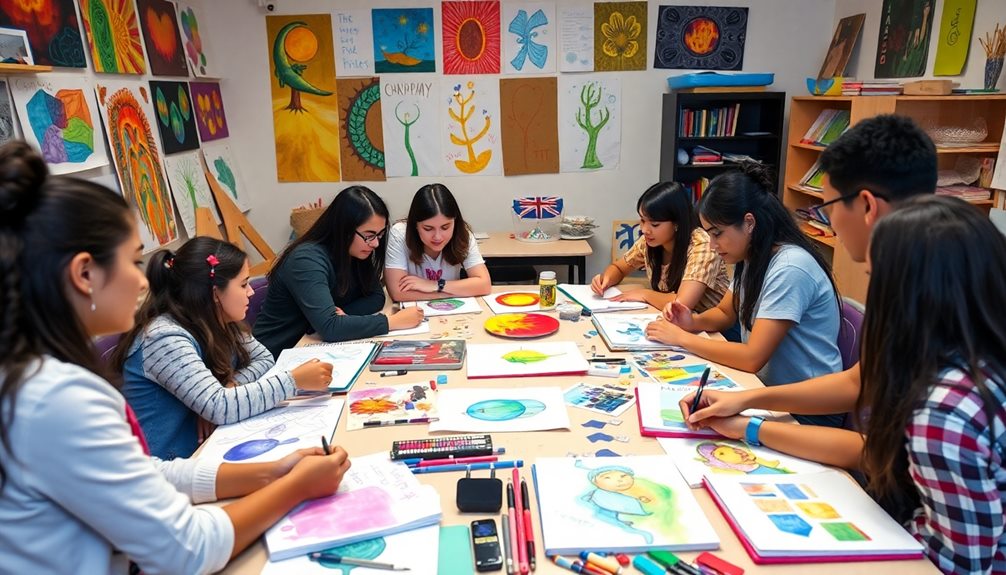
Exploring art through collaboration can greatly enhance your experience and comprehension of the subject. By incorporating collaborative activities, you foster a sense of community among a group of students, allowing them to engage more deeply with artworks.
For instance, the Puzzle Activity encourages pairs to analyze segments of an artwork, promoting teamwork and deeper discussion about visual elements and interpretations.
Another effective method is the Collaborative Mural Project, where students collectively contribute to a large-scale artwork, celebrating diverse artistic styles and ideas. This not only builds camaraderie but also enhances critical thinking as students share their unique perspectives.
Engaging in group discussions through the Think, Puzzle, Explore Method allows students to connect personally with the artwork, further deepening their understanding.
Activities like the Art Detective Agency encourage students to examine details together, honing their observational skills while fostering inquiry-based learning.
Finally, Collaborative Collage projects enable students to brainstorm and create as a team, enhancing their ability to communicate and express artistic ideas collectively.
Frequently Asked Questions
How to Teach Students to Analyze Art?
To teach students to analyze art, encourage them to observe closely, ask questions, and express their thoughts. Use collaborative activities to deepen understanding, and promote descriptive language to enhance their observational and analytical skills.
How Can I Make My Art Class Interesting?
To make your art class interesting, blend observation with exploration. Encourage students to dive deep into artworks, ask questions, and share insights. Incorporate hands-on activities, fostering collaboration and making connections to their own experiences.
How Do You Structure an Art Analysis?
To structure an art analysis, start with observation, then describe what you see. Next, interpret the meaning and connect it to your experiences. Use questions throughout to deepen your understanding and encourage critical thinking.
How to Make Art History More Engaging?
To make art history more engaging, you'll want to incorporate interactive activities, storytelling, and virtual tours. Encourage curiosity through exploration and hands-on projects, creating connections between students and the historical narratives behind the artworks.
Conclusion
Incorporating engaging art analysis activities transforms your classroom into a vibrant gallery where ideas bloom like wildflowers. Just as a gardener nurtures each plant, you cultivate your students' critical thinking and creativity. By using effective techniques and collaborative projects, you help them dig deep into the meaning behind each artwork. Remember, every discussion about art is like planting a seed—give it the right care, and you'll watch their appreciation for art flourish before your very eyes.






